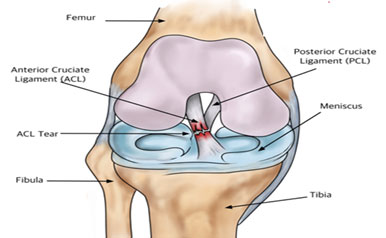ACL Tear or ACL Injury – A closer look at one of the most common injuries in sporting
Whether you play sport professionally, casually, or even just watch it, it would be unlikely that you haven’t heard of someone “doing their ACL”, as it’s often put. ACL tear and ACL injuries are right up there in the most common injuries suffered by athletes. So what is it, and why does it happen so often in sports?
The anterior cruciate ligament (commonly referred to as the ACL) is one of the major ligaments providing stability for the knee. Located at the centre of the knee, it is a strong, rope-like structure, running from the femur to the tibia.
Ligaments, which are responsible for holding bones and cartilage and joints together can tear when they’re overstretched, and when the ACL tears, unfortunately, it doesn’t heal and often leads to instability in the knee.
ACL injuries occur most commonly during sports and can happen in several ways. A sudden directional change (where twisting occurs in the knee), slowing down while running, landing from a jump incorrectly, or a direct blow to the side of your knee can all cause an ACL tear.
ACL tears are very painful, and some patients even report hearing a popping sound from the knee at the time of the injury. Aside from the obvious pain at the site of the tear, other symptoms can include swelling of the joint and a feeling of instability (like your knee is going to dislocate or “pop out”.
Various treatment options, both surgical and non-invasive are available for ACL tears, but as with most sporting injuries, prevention is better than a cure (or treatment). A lot of the time these injuries occur, it’s either because the player / athlete isn’t conditioned to the level they’re playing at (not enough practice). For example, you wouldn’t run a marathon for your first foray into running. You should start small and build up slowly and steadily to where you want to be.
ACL tears can also happen when they haven’t warmed up properly. For injury prevention in any sport, appropriately warming up and stretching all the relevant muscles and ligaments is essential. Stretching and warm-up exercises increase blood flow and flexibility, decreasing the risk of suffering serious injuries.
Another guaranteed way to suffer an injury is by attempting to carry on after you’ve exhausted yourself. This is when your guard is down, and you become more vulnerable to injury. Know when your time is up and you’ve done your best, and don’t try to be a hero.
Unlike a sprain, these injuries don’t repair themselves so if you believe you may have torn your ACL, it is essential you seek medical assistance.

